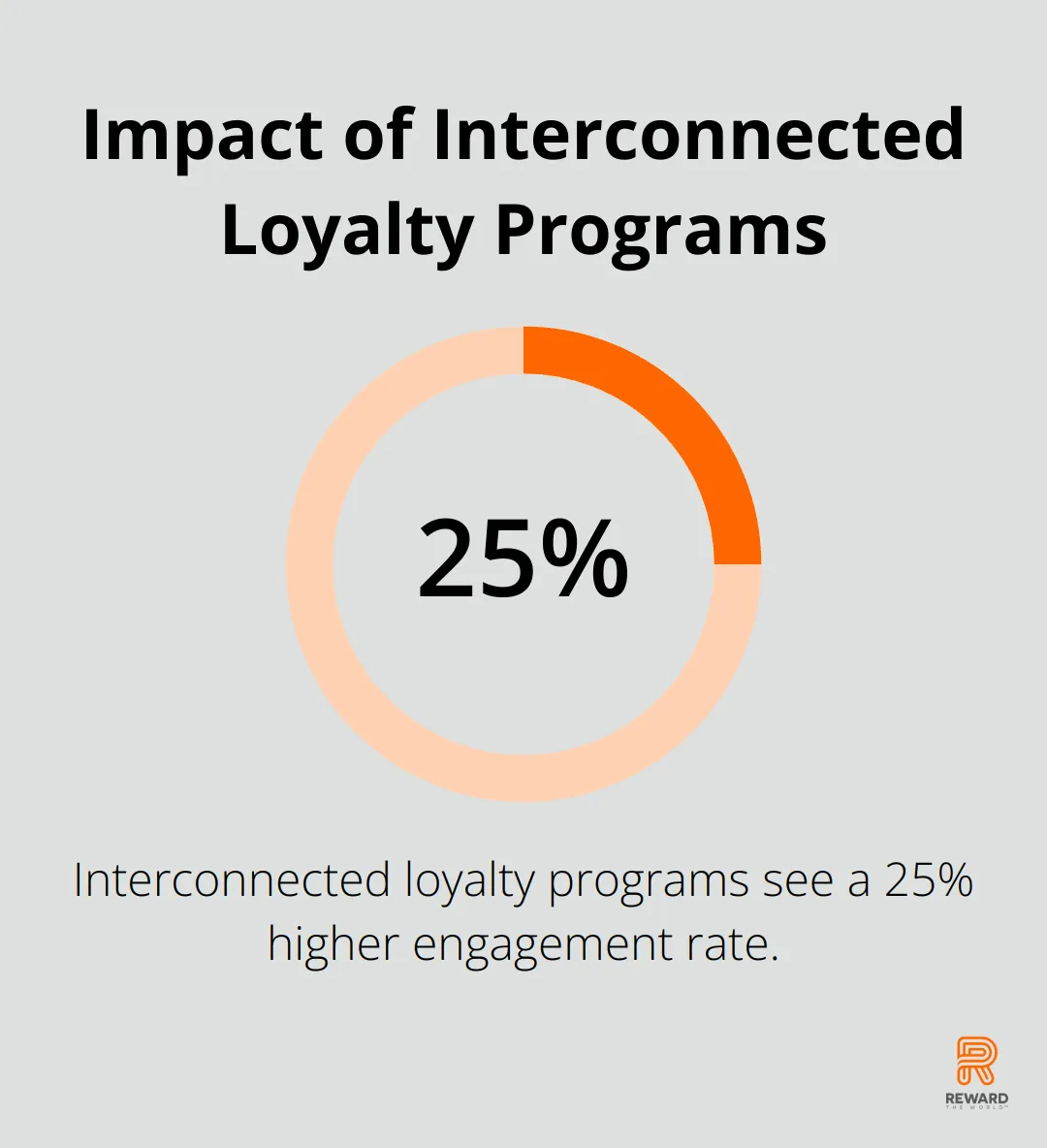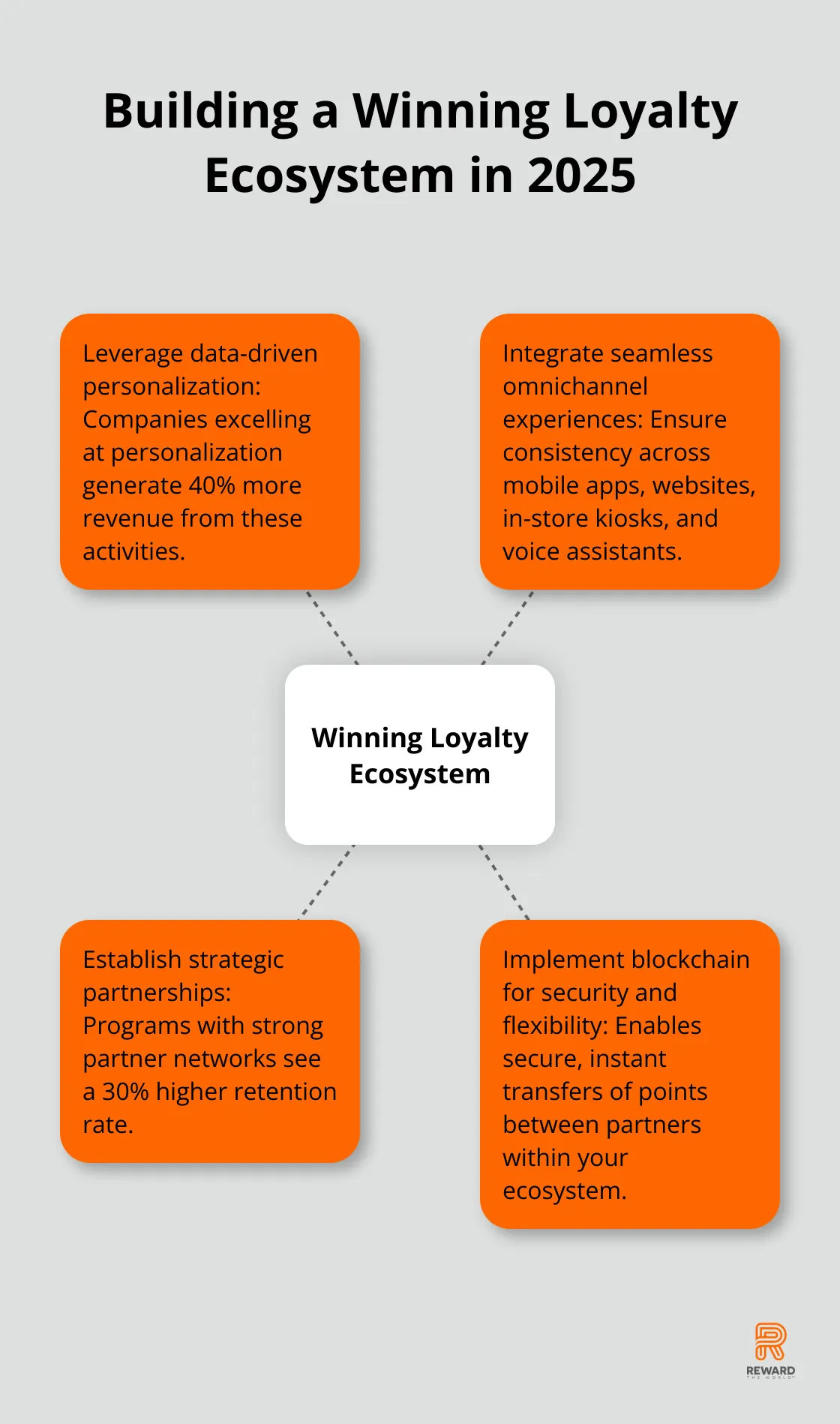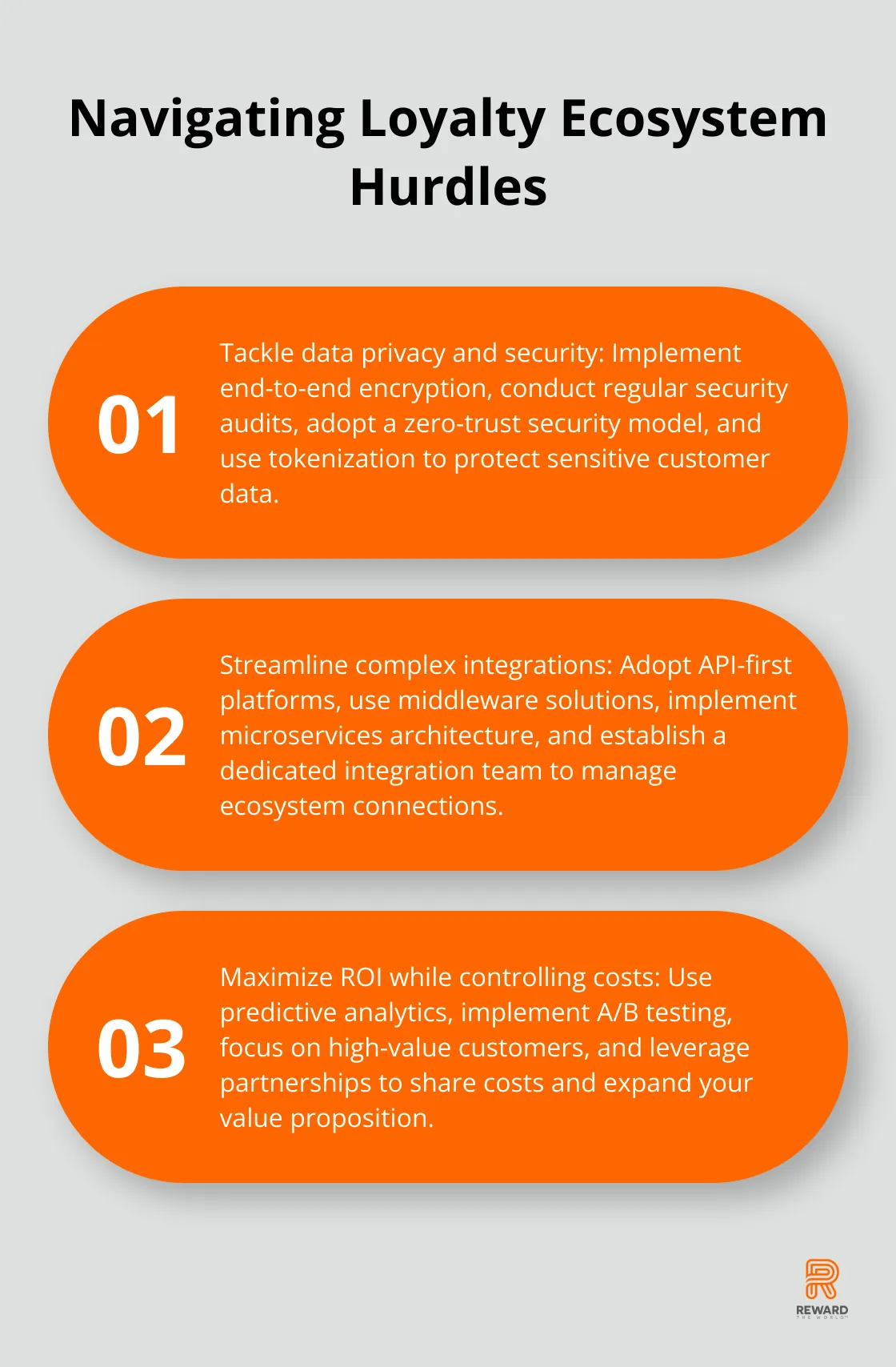
Loyalty ecosystems are reshaping the way businesses engage with customers in 2025. At Reward the World, we’ve seen firsthand how interconnected loyalty programs drive customer retention and boost revenue.
This blog post will guide you through building a thriving loyalty ecosystem, from leveraging data analytics to implementing blockchain rewards. We’ll also address common challenges and provide practical strategies for success in this evolving landscape.
What Is a Modern Loyalty Ecosystem?
The Evolution of Loyalty Programs
In 2025, loyalty ecosystems have transformed into intricate networks that extend far beyond traditional point-based systems. At Reward the World, we define a loyalty ecosystem as an interconnected web of partnerships, technologies, and customer touchpoints that collaborate to create a seamless and personalized loyalty experience.
Core Components of a Loyalty Ecosystem
A modern loyalty ecosystem consists of several key elements:
- The core loyalty program (tracks customer interactions and rewards)
- Data analytics platform (processes customer information for insights)
- Various customer interaction channels (mobile apps, websites, in-store experiences)
- Network of partners (expands the program’s reach and value proposition)
The Power of Interconnected Programs
Interconnected loyalty programs prove vital in today’s market. A 2024 Forrester study found that programs balancing brand individuality with overall cohesion see a 25% higher engagement rate. This success stems from the increased value and convenience offered to customers, who can earn and redeem rewards across multiple touchpoints and partners.

Industry Leaders Shaping the Landscape
Several companies lead the charge in loyalty ecosystem development:
- Amazon Prime: A vast ecosystem encompassing shopping, streaming, and delivery services
- Starbucks Rewards: Integrates mobile ordering, payment, and personalized offers
- Rakuten: Built a loyalty ecosystem spanning e-commerce, fintech, and telecommunications
- Reward the World: Offers a dynamic global incentives platform available in 15 languages with a 250 million-user base (making it a top choice for businesses seeking comprehensive loyalty solutions)
Technology’s Role in Ecosystem Development
Advanced technologies play a pivotal role in shaping loyalty ecosystems. AI and machine learning enable hyper-personalization, with companies using these technologies to create tailored experiences for each customer, moving far beyond the traditional one-size-fits-all approach. Blockchain also makes waves, with some loyalty programs using it to create secure, transparent, and easily transferable reward currencies.
Measuring Ecosystem Success
To evaluate the effectiveness of your loyalty ecosystem, focus on metrics that reflect customer engagement and business impact. Key indicators include:
- Net Promoter Score (NPS)
- Customer Lifetime Value (CLV)
- Program participation rates
- Cross-partner engagement (assesses how well your ecosystem drives value across different touchpoints)
As we move forward, we’ll explore strategies for building a successful loyalty ecosystem that capitalizes on these components and technologies.
How to Build a Winning Loyalty Ecosystem in 2025
Leverage Data-Driven Personalization
The foundation of a thriving loyalty ecosystem rests on data and analytics for hyper-personalization. A 2024 McKinsey report reveals that companies excelling at personalization generate 40% more revenue from these activities than average players. Implement a robust Customer Data Platform (CDP) to consolidate data from various touchpoints. This approach allows you to create detailed customer profiles and deliver tailored rewards and experiences.
Sephora’s Beauty Insider program exemplifies this strategy. By using purchase history and browsing behavior, they recommend products and offer personalized samples. This tactic has resulted in a 200% increase in their conversion rate for personalized product recommendations.
Integrate Seamless Omnichannel Experiences
Customers in 2025 expect frictionless experiences across all channels. Integrate your loyalty program across mobile apps, websites, in-store kiosks, and even voice assistants. Starbucks sets the standard with their Rewards program, enabling customers to order ahead, pay, and earn stars through their app, website, or in-store.
To achieve this level of integration, invest in API-first platforms that connect easily with various systems and touchpoints. This approach enables real-time updates and ensures consistency across all channels (a key factor in customer satisfaction).

Establish Strategic Partnerships
Expanding your loyalty ecosystem through partnerships can significantly increase its value proposition. A 2024 Accenture study found that loyalty programs with strong partner networks see a 30% higher retention rate compared to standalone programs.
Identify complementary businesses that align with your customer base. For instance, a fitness app could partner with a healthy meal delivery service and a sportswear brand to create a holistic wellness rewards program (providing added value to health-conscious consumers).
When selecting partners, prioritize those who can integrate seamlessly with your existing technology stack. This ensures a smooth customer experience and simplifies data sharing for more effective personalization.
Implement Blockchain for Security and Flexibility
Blockchain technology revolutionizes loyalty programs by offering enhanced security, transparency, and flexibility. Implement a blockchain-based reward system to enable secure, instant transfers of points between partners within your ecosystem. This not only enhances the perceived value of your rewards but also opens up new possibilities for cross-promotion and engagement.
As we move forward, it’s essential to address the challenges that come with building and maintaining a complex loyalty ecosystem. Let’s explore some common hurdles and strategies to overcome them in the next section.
Navigating Loyalty Ecosystem Hurdles
Tackle Data Privacy and Security
Data breaches can destroy customer trust. Companies that experienced data breaches in 2024 saw a 23% drop in customer loyalty (Ponemon Institute study). To safeguard your ecosystem:
- Implement end-to-end encryption for all data transfers.
- Conduct regular third-party security audits to identify vulnerabilities.
- Adopt a zero-trust security model (verify every access request regardless of source).
- Use tokenization to protect sensitive customer data.
Streamline Complex Integrations
Integration complexity often slows ecosystem development. A 2024 Gartner report found that 67% of companies struggle with integrating multiple systems in their loyalty programs. To simplify integration:
- Adopt API-first platforms for easy connectivity.
- Use middleware solutions to bridge gaps between legacy systems and new technologies.
- Implement a microservices architecture for modular, scalable development.
- Establish a dedicated integration team to manage ecosystem connections.

Maximize ROI While Controlling Costs
Balancing costs and returns is essential. The 2024 Loyalty Report by Bond Brand Loyalty revealed that top-performing loyalty programs deliver 3.5 times more value than bottom performers. To optimize your ROI:
- Use predictive analytics to forecast the impact of loyalty initiatives.
- Implement A/B testing for new features before full rollout.
- Focus on high-value customers (the top 20% often generate 80% of profits).
- Leverage partnerships to share costs and expand your value proposition.
Adapt to Evolving Consumer Expectations
Consumer preferences change rapidly. To stay ahead:
- Implement AI-driven personalization engines that adapt to customer behavior in real-time.
- Offer experiential rewards (65% of millennials value experiences over material goods).
- Integrate sustainability into your loyalty ecosystem.
- Provide instant gratification through immediate rewards or point redemption options.
Final Thoughts
Loyalty ecosystems will shape customer engagement in 2025 and beyond. Data-driven personalization, omnichannel experiences, strategic partnerships, and blockchain technology will drive customer retention and boost revenue. Companies must address challenges like data privacy, integration complexity, and cost management to succeed in this evolving landscape.
AI and machine learning will enable more sophisticated personalization in loyalty ecosystems. We expect increased integration of sustainability initiatives and a growing emphasis on community-building within loyalty programs. As ecosystems expand, new opportunities for cross-sector collaboration and value creation will emerge (blurring the lines between industries).
We at Reward the World help businesses build and optimize their loyalty ecosystems. Our platform offers instant reward delivery, seamless integration, and robust analytics. Companies that invest in comprehensive loyalty ecosystem strategies now will thrive in the customer-centric future of 2025 and beyond.
